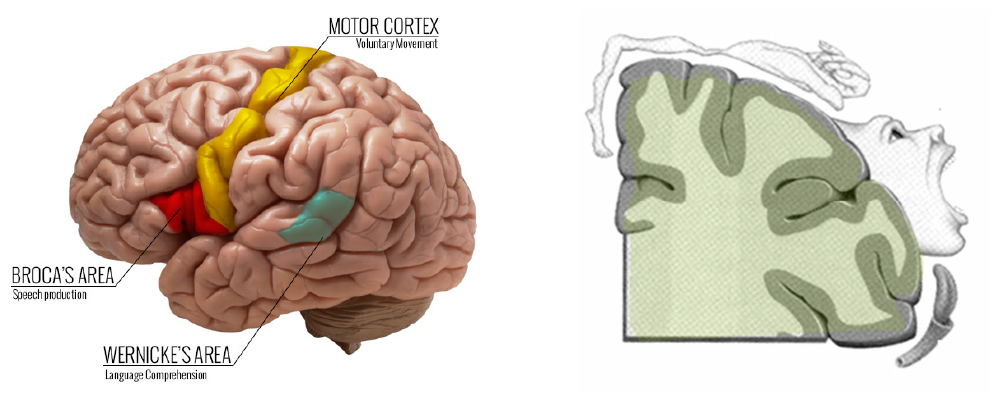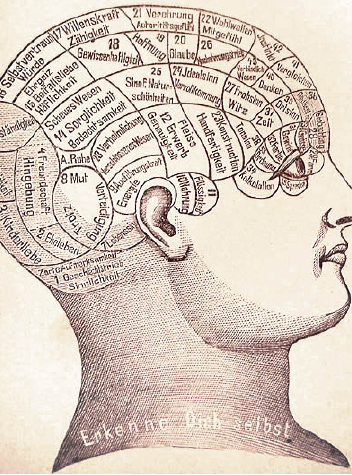No one can say that the great scientists, anatomists, and philosophers of the past were dull in describing the brain. It can be said, however, that some were less accurate than others. Brilliant minds built intricate models that flourished briefly, but crumbled with the passage of time.
Localization, the idea of a brain divided into parts with distinctive functions, has been the front-running theory for quite a while, but recent research has started putting up some strong opposition.
Phrenology
Franz Joseph Gall was a physician who began his work in the late 18th century, forging his own intriguing (and oddly influential) path through the world of neuroscience.
Gall rooted his theory in several fundamental propositions. First, he claimed that distinct parts of the brain, known to him as “organs”, house the “aptitudes and tendencies” which account for our personalities , and that these organs develop over time.
Next, he proposed that the development of these organs must be responsible for the shape of the skull. Gall believed that the organs respond to experience by growing accordingly, so he reasoned that for the skull to accommodate changes, it must be altered [1].
With these underlying principles in mind, and a goal to try and quantify human nature, Gall set out documenting the locations of the specific organs thinking he would be able to relate the bumps on peoples’ skulls to character traits that corresponded to the organ producing the protuberance.
Gall referred to his work as “the physiology of the brain”, but it came to be widely known as phrenology in the 1820s [2].

Initially, his theory did not go over well. Gall’s work was opposed by Vienna’s emperor Franz II – or more likely his personal physician – and was banned just after the turn of the century.
Ironically, the ban brought more attention to Gall’s work than he had previously received [2]. The rush of curiosity paved the way for Gall to lead a successful tour of Europe, where he discussed his ideas and demonstrated his methods. People began to take serious notice of Gall’s ideas about a brain with discrete, identifiable functions. From this point on, phrenology would be adopted and adapted worldwide.
As Gall’s ideas disseminated, phrenology increasingly asserted its presence as a cultural and “scientific” phenomenon. Businesses were started in which, for a small fee, people could have their cranial bumps read and interpreted in order to learn about all aspects of their character [3][5].
In a matter of time machines called “phrenometers” were produced that were said to have the ability to “tell one’s “bumps” with extreme accuracy, and present the victim immediately with a printed chart of their virtues and vices" [4]. In America, phrenology attracted the attention of many now historical figures, such as Walt Whitman, Ralph Waldo Emerson, and Mark Twain [3].
From the start, however, there were many members of the scientific community who fervently opposed phrenology, calling Gall a charlatan and accusing him of being more interested in phrenology’s contribution to his own personal wealth than what it could do as a science [2].
Modern Localization
Although phrenology as stated by Gall is now recognized entirely as a pseudo-science, it is clear that it left its mark as one of history’s novelties. Gall’s real legacy to science is contained in the fact that he firmly popularized the idea of localized brain function, which argues that certain parts of the brain are in charge of controlling specific tasks. This modern idea of localization has been championed in many different forms by many different authorities, sending droves of scientists down countless avenues of research.

Broca’s Area
Paul Broca was one of the earliest and most famous proponents of modern localizationism. Elaborating on Jean-Baptiste Bouillaud’s work of locating the brain’s center of speech articulation, Broca began studying a patient known as Tan [6]. Tan had a condition known as aphasia, which had rendered him nearly speechless for 21 years by the time Broca began his research.
The name Tan came from the fact that the single syllable ‘tan’ was all he was able to pronounce after losing the ability to speak fluently.
Broca subjected Tan to all sorts of tests while working with him, mainly asking him general comprehension questions that could be answered without words. When he realized Tan was able to comprehend and provide correct answers to his questions, Broca determined that Tan’s inability to speak was not due to an extreme lack of intelligence; it was more likely, he ventured, that only a particular area of Tan’s brain had been damaged.
After Tan’s death, an autopsy confirmed that a region towards the front left hemisphere of the brain, known by Broca as the “third frontal convolution”, appeared to be origin of the damage [6]. Because Tan’s increasing trouble with words coincided with the degeneration of this part of the brain, Broca concluded that this particular area must be heavily involved in speech articulation. Today, this region is known as Broca’s area in honor of his discovery [7].
After Broca’s breakthrough, the paradigm in neuroscientific research became Divide and Conquer. Carl Wernicke expounded on Broca’s research of speech, and in 1874 published his findings detailing the part of the brain that deals with speech comprehension [7][8].
Cortical Homunculus
Another landmark for localization came in the 1930s when Wilder Penfield developed his Penfield Homunculus, a map relating the surface area of the brain’s cortex to the bodily function it controls [9]. There are two homunculi, motor and sensation, that show a proportionally distorted representation of the body according to the neurons dedicated to that region (see figure above). The historical obsession with seeking out parts of the brain that control similar functions and segregating them based on their apparent roles has engrained the theory of localization into neuroscientific doctrine.
Modern Modularity
Even with localization’s well-established foundation, modern neuroscience looks as if it may be ushering in a new era.
The rise of theories that suggest heavy interconnectivity between different regions of the brain have the potential to drastically reshape many aspects of our current understanding. As with many other binary disagreements in science, the true nature of the brain is probably not as black-and-white as has been assumed. More likely, the brain’s functionality depends on a combination between strict localization and global interconnectivity.
Perhaps as research continues and the field matures, scientists will be less tempted to provide simplifying explanations in favor of those which can account for the unparalleled complexity of the brain.
